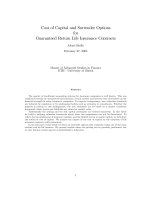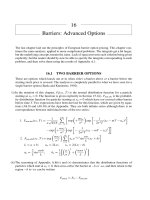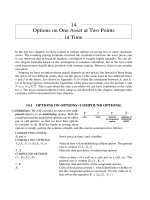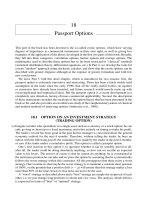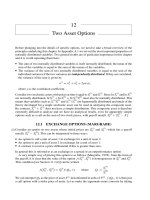Passport Options
Bạn đang xem bản rút gọn của tài liệu. Xem và tải ngay bản đầy đủ của tài liệu tại đây (184.08 KB, 7 trang )
18
Passport Options
This part of the book has been devoted to the so-called exotic options, which have varying
degrees of importance as commercial instruments in their own right, as well as giving live
examples of the application of the theory developed in the first two parts of this book. Broadly,
they fall into three categories: correlation options, barrier options and average options. The
mathematics used to describe these options has so far been restricted to “classical” methods
(statistical distribution theory, differential equations, etc.) In Part 4, we develop the tools for
a more “modern” approach using stochastic calculus, and show that the exotic options can be
described with greater elegance although at the expense of greater formalism and with few
new conclusions.
We leave Part 3 with this short chapter, which is introduced for two reasons: first, the
passport option is extremely innovative and interesting. There has been a fairly widely held
assumption in the trade since the early 1990s that all the really useful exotics on equities
or currencies have already been invented, and future research would merely come up with
overcomplicated and impractical ideas. But the passport option is a recent development in a
completely new direction, having obvious commercial applicability. Second, the description
of these instruments stretches the envelope of the option theory that has been presented in the
book so far, and also provides an excellent case study of the complementary nature of classical
and modern methods of analyzing options (Andersen et al., 1998).
18.1 OPTION ON AN INVESTMENT STRATEGY
(TRADING OPTION)
(i) Imagine a trader who specializes in a single asset such as a currency or a stock option; he can
only go long or short up to a fixed maximum, and relies entirely on timing to make his profit.
The trader’s record has been good in the past but his manager is concerned about the general
economic outlook for the next 6 months. Therefore, without telling the trader, he buys an
option with the following payoff: the cumulative loss made by the trader in the next 6 months,
or zero if the trader makes a cumulative profit. This option is called a passport option.
One’s first reaction to this option is to question whether it can be sensibly priced at all:
after all, the trader could be doing absolutely anything, so how can we ascribe an expected
value to his losses. The answer of course is that he cannot do anything; he is constrained in
the maximum position he can take and we price the option by assuming that he systematically
follows the worst strategy within this constraint. All this presupposes that there exists a worst
strategy. One’s instinct is that maybe the worst strategy is to maintain a constant short position
of 100%, on the grounds that a positive drift (r − q) will ensure that this strategy makes a loss
more than 50% of the time; however, this turns out not to be the case.
A “worst” strategy as described above and a “best” strategy are simply the reciprocal of each
other, i.e. we just change long positions to shorts and vice versa. The analysis which follows
is expressed in terms of “best” or “optimal” strategy.
18 Passport Options
Our approach will be to derive a differential equation using just the same riskless hedge
approach as we used to derive the Black Scholes equation in Section 4.2 . The optimum strategy
will emerge as a by-product, together with an option replication strategy.
(ii) The Trading Option: This is specified as follows. A trader manages a stock position in such
a way that he may never be more than one share long or short (fractional shares allowed). He
manages according to a strategy u
t
, where u
t
is the amount of shares held at time t, and is
subject to the constraint |u
t
| < 1.
Examples of strategies are:
r
At the beginning of each day go long or short depending on what would have made money
yesterday.
r
Go long on odd days and short on even days.
r
Take positions that replicate a put option.
An example of a strategy, which we do not consider for obvious reasons, is “go long on days
when this produces a profit”.
The cumulative profit/loss generated by a strategy between time zero and t is written w
t
.
The trading option is defined as having payoff max[0,w
T
] and the value of this option is given
by
f = e
−rT
E[max[0,w
T
]]
risk neutral
The precise value of f obviously depends on the precise strategy u
t
which generates w
t
,but
we keep the argument general for the moment.
(iii) Partial Differential Equation for Trading Option: It is assumed that S
t
and w
t
follow the
Wiener processes
δS
t
= (µ − q)S
t
δt + σ S
t
δW
t
and δw
t
= u
t
δS
t
Be careful not to confuse w
t
and W
t
: unfortunate, but this is the most common notation.
Assume that we can construct a riskless portfolio consisting of one unit of option and −
units of the underlying stock; its value is f −
t
S
t
and its shift in value over a small interval
is δ f −
t
δS
t
. Since it is riskless, its rate of return must equal the risk-free return, so that
δ f −
t
δS
t
− qS
t
t
δt = ( f −
t
S
t
)rδt (18.1)
So far, we are headed towards deriving the Black Scholes equation again; but this time, f also
depends on w
t
so that the Taylor expansion is
δ f =
∂ f
∂t
δt +
∂ f
∂ S
t
δS
t
+
∂ f
∂w
t
δw
t
+
∂
2
f
∂ S
2
t
(δS
t
)
2
+ 2
∂
2
f
∂ S
t
∂w
t
(δS
t
∂w
t
) +
∂
2
f
∂w
2
t
(δw
t
)
2
In addition to the substitution (δS
t
)
2
→ S
2
t
σ
2
δt which we previously used for deriving the
Black Scholes equation, we now have the following: (δw
t
)
2
→ u
2
t
S
2
t
σ
2
δt and (δS
t
δw
t
) →
u
t
S
2
t
σ
2
δt. Putting these into the Taylor expansion gives Ito’s Lemma for this particular problem,
analogous to equation (3.12):
δ f =
∂ f
∂t
+ S
2
t
σ
2
∂
2
f
∂ S
2
t
+ 2u
t
∂
2
f
∂ S
t
∂w
t
+ u
2
t
∂
2
f
∂w
2
t
δt +
∂ f
∂ S
t
+ u
t
∂ f
∂w
t
δS
t
218
18.1 OPTION ON AN INVESTMENT STRATEGY
Plugging this back into equation (18.1) and setting the coefficient of δW
t
equal to zero (since
the deal is risk-free) gives
∂ f
∂t
+ S
2
t
σ
2
∂
2
f
∂ S
2
t
+ 2u
t
∂
2
f
∂ S
t
∂w
t
+ u
2
t
∂
2
f
∂w
2
t
+ (r − q)S
t
∂ f
∂ S
t
+ u
t
∂ f
∂w
t
= rf
and
=
∂ f
∂ S
t
+ u
t
∂ f
∂w
t
(18.2)
This looks like a complex PDE in two “space” variables S
t
and w
t
; but for fixed u
t
, S
t
and w
t
have perfect correlation, i.e. they are not really different variables. We now look for a single
variable that serves for both.
(iv) Transformed PDE for a Trading Option: The homogeneity arguments of Section 11.1(ii)
indicate that the trading option price is a homogeneous function of S
t
and w
t
, so that
f (t, S
t
,w
t
) = S
t
f (t,w
t
/S
t
) = S
t
v(t, x
t
) where x
t
= w
t
/S
t
This change of variable can be applied to equations (18.2) using the following transformations:
∂ f
∂ S
t
= v − x
t
∂v
∂x
t
;
∂
2
f
∂ S
2
t
= x
t
∂
2
v
∂x
2
t
∂ f
∂w
t
=
∂v
∂x
t
;
∂
2
f
∂w
2
t
=
1
S
t
∂
2
v
∂x
2
t
;
∂
2
f
∂ S
t
∂w
t
=−
x
t
S
t
∂
2
v
∂x
2
t
so that the equations become
∂v
∂t
+ (u
t
− x
t
)(r − q)
∂v
∂x
t
+
1
2
σ
2
(u
t
− x
t
)
2
∂
2
v
∂x
2
t
= qv
and
t
= v + (u
t
− x
t
)
∂v
∂x
t
(18.3)
with boundary condition v(T ) = max[0, x
T
].
v
v(T)
t
x
v(t)
Figure 18.1 Trading option price
(v) In terms of the parameter x
t
, the payoff v(T ) of the op-
tion is given by the usual hockey-stick payoff diagram
with v(t) having the general form of the dotted curve
in Figure 18.1. The precise form of v(t) will of course
depend on the exact form of the strategy u
t
employed.
However, it is apparent from the general form of the
v(t) curve that
0 ≤
∂v(t )
∂x
t
and 0 ≤
∂
2
v(t)
∂x
2
t
(18.4)
219
18 Passport Options
18.2 OPTION ON AN OPTIMAL INVESTMENT STRATEGY
(PASSPORT OPTION)
(i) The Optimal Strategy: We now pose the following question: “Is there some optimal strategy
which could be followed by our hypothetical portfolio manager, which gives a greater expected
return than all others?” If there is, an option on this strategy would be more expensive than
options on all other strategies. We therefore turn the question on its head and ask: “what strategy
maximizes the value of a trading option?”.
Equation (18.3) may be rewritten as
v(t) =
1
q
Au
2
t
+ Bu
t
+ C
where
A ≡
1
2
σ
2
∂
2
v(t)
∂x
2
t
; B ≡ (r − q)
∂v(t )
∂x
t
− x
t
σ
2
∂
2
v(t)
∂x
2
t
C ≡
∂v(t )
∂t
− x
t
(r − q)
∂v(t )
∂x
t
+
1
2
x
2
t
σ
2
∂
2
v(t)
∂x
2
t
Write U
t
as the value of u
t
for the strategy that maximizes v(t) in the last equation. Some
critical points emerge:
r
B and C may be positive or negative; but from equation (18.4), we always have 0 ≤ A.We
assume 0 < q.
r
It follows that v(t) is a maximum if u
t
is as large as possible; but remember that u
t
is
restricted to −1 < u
t
< +1. The optimal strategy therefore has U
2
t
= 1orU
t
=±1.
r
Switching our attention to the second term in brackets, v(t) is a maximum if BU
t
is always
positive, i.e.
U
t
= sign B = sign
(r − q)
∂v(t )
∂x
t
− x
t
σ
2
∂
2
v(t)
∂x
2
t
(18.5)
where sign a =+1(0 ≤ a), −1(a < 0).
This completely defines the optimal strategy. From equation (18.3), the delta of the option is
given by
= v(t) + (sign B − x
t
)
∂v(t )
∂x
t
so that the delta jumps each time the sign of B changes.
(ii) Driftless Solution: We should now be in a position to solve the partial differential equation,
finding an analytical expression for v(t), and hence for the value of a passport option. But
disappointingly, equation (18.3) is too hard to solve, except in the driftless case where r = q
and U
t
= sign B = sign x
t
= sign w
t
and so
∂v(t )
∂t
+
1
2
σ
2
(1 +|x
t
|)
2
∂
2
v(t)
∂x
2
t
= qv(t)
An analytical solution may be obtained for this using Laplace transforms; however, in view of
the restricted applicability, we will not derive an explicit formula here.
220
18.2 OPTION ON AN OPTIMAL INVESTMENT STRATEGY
(iii) Intuitive Analysis: At this point it is worth stepping back to reflect on the optimum solution
we have found, and its implications. Confronted with the passport problem for the first time,
most people would give the following intuitive analysis:
(A) The Wiener process δS
t
= (r − q)S
t
δt + σ S
t
δW
t
implies that E[S
T
] = S
0
e
(r−q)T
.
(B) The optimum trading strategy should therefore be to stay 100% long if the drift (r − q)is
positive, since there is more than a 50–50 chance of an up move. If the drift is negative,
stay 100% short.
(C) Price the passport option to correspond to the strategy laid out in the last point, i.e. as a
call if the drift is positive and as a put if it is negative.
(D) If there is an accumulated trading profit/loss w
0
at t = 0, this is merely set aside and
accounted for at the end; it will not affect the value of the passport option except in a
trivial, additive way.
Point (A) is undisputed. Looking at equation (18.5) shows that point (B) is almost true: the first
term in curly brackets is just a restatement of (B) and this term is usually the dominant term; but
there is an important second term which the intuitive analysis has missed. It is this term which
prevents us from using the recipe in point (C) to price a passport option. The reason why the
intuitive analysis does not hold true is that point (D) is false, as is simply demonstrated below.
value
put
0
S
call
value
Figure 18.2 Driftless case with w
0
= 0
(iv) Let us examine the driftless case (r − q = 0). The in-
tuitive analysis above would imply that there is no op-
timal strategy; the expectations of long, short and zero
positions are the same. This option could therefore be
priced as either a put or a call. In the even more re-
stricted circumstance where the accumulated trading
profit is exactly zero (w
0
= 0), this is indeed the case.
Figure 18.2 shows the well-known symmetry of put
and call options with the same strike (at-the-money).
But unfortunately, as soon as w
0
= 0, this symmetry
all breaks down.
To see why, consider the following simple, one-period model: instead of a continuous trading
strategy, the trader has to decide at t = 0 whether to go long or short for the entire period.
Depending on whether he goes long or short, the payoff will be
Payoff
long
=
max[0, S
T
− (S
0
− w
0
)] w
0
< S
0
w
T
S
0
<w
0
Payoff
short
= max[0, (S
0
+ w
0
) − S
T
]
It is already obvious from the asymmetry of the payoffs in this simple model that the option
value depends on the initial trading profit w
0
in some non-trivial way (i.e. not simply additive).
Clearly, in the real world where the trader has the continuous ability to change his position,
the value of the passport option will also depend on the cumulative profit. Remember, we are
still considering the driftless case, where we had previously advanced the argument that there
is no optimal strategy.
The underlying reason for the intuitive arguments not working are easy to trace back. In our
simple one-period model, the asymmetry was caused by the fact that S
t
cannot be less than
zero. In fact, the whole issue can be traced back to an alternatively stated description of the
221


